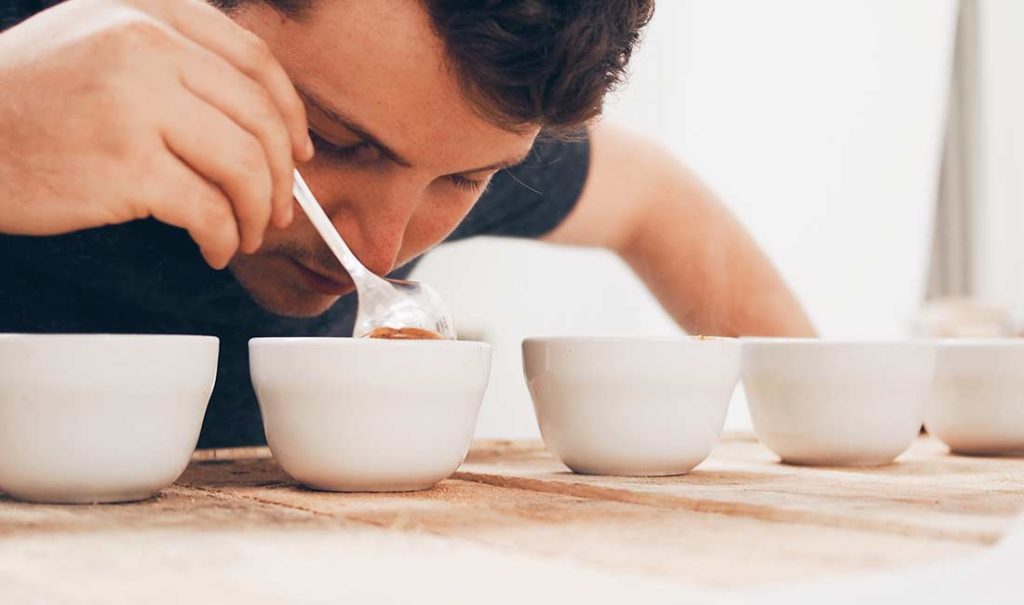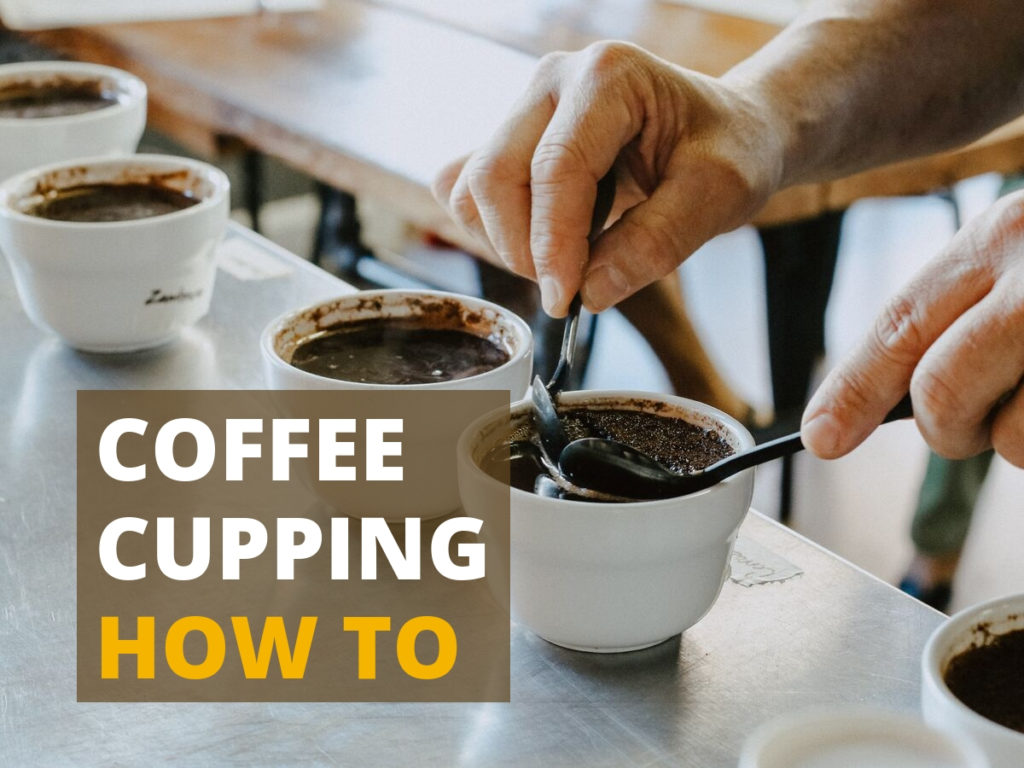Coffee cupping is the systematic process of tasting coffee in order to determine its unique characteristics and quality level. It is primarily used by those making decisions about which green coffee beans to purchase, but it can also be a learning tool for baristas or a fun activity for customers.
In order to have a coffee cupping, a roasters will roast small batches of different green coffees. These small batches are then prepared in very specific ways and presented to a group of people who evaluate the characteristics of the coffee. In order to keep the tasting unbiased, special care is taken to roast, grind, and prepare each coffee exactly the same way.
Can I cup coffee even if I’m not a green buyer?
Of course! The process of cupping coffee is not solely for those buying and roasting the coffee. By participating in cupping, one can develop an educated opinion and valuable coffee knowledge. Speciality coffee retailers also often hold cuppings to screen the freshness, flavor, and quality of the coffee they will sell to their customers. Employees can also participate to grow their coffee knowledge in order to better be able to answer customer questions regarding flavor and origin of different coffees. Listing these characteristics within your establishment can also educate customers and often leads to more sales.
Speciality coffee interest has grown to a similar level of sophistication as fine wine. Consumers are expressing more interest in being more actively involved in the comprehension of origin, roast, and blending of the coffee they are consuming. These consumers are looking to those in speciality coffee operations for their expertise.

Cupping Tools
To conduct a proper coffee cupping, one will need the following items:
- A coffee cupping tray
- One small grinder and scale (e.g. a Burr grinder) that produces a consistent grind
- A digital scale
- One tea kettle for the near-boiling water (192-200°F)
- Several 7.5-ounce porcelain cupping bowls
- Cupping spoon(s)
And for those really serious about getting into cupping, we highly recommend the following bundle package: Coffee Cupping Kit for 3
The Cupping Process
This process should ideally be conducted in a quiet, isolated room absent from strong fragrances.
Once you find this environment, organize your cupping tools and label the coffees to be tasted. Be sure to take notes after each sample is tasted. Keep a cup of clean water available to rinse your spoon between each sample and an empty cup to deposit coffee after tasting.
Visual examination is also an important aspect of cupping; each coffee bean sample should be spread out on its own plate. Important aspects to note are surface texture (smoothness), the colors, the size, the shape (uniform or not), and oil presence (contributes to the “body” of the brewed coffee). Visible oils and having a darker roast does not always indicate that the bean is superior quality. This visual examination of the coffee beans helps you relate the flavor and aroma of the different coffees to be tasted.
More experienced buyers tend to use this visual examination to look for deficiencies such as disease marks, bean fragments, and a presence of foreign objects (rocks and sticks), all of which indicate a lack of care when selecting the beans.
Procedures to Conduct the Cupping:
- Grind each sample to a medium- consistency (will look similar to raw sugar)
- Fill your cup with 8-14 grams of fresh coffee grinds (or 2 heaping tablespoons)
- In the same cup, add 6 ounces of hot water (at approximately 200°F)
- Steep the coffee for 2-3 minutes. A “cap” or crust should form on the coffee’s surface.
- While the coffee steeps, continue to check the fragrances. Sour smells insinuate the coffee is stale or the green coffee beans had fermented before drying.
- Gently break this cap with the spoon. You should notice a fine-celled foam as you move the spoon lightly back and forth across the cap.

If no foam presents itself during this process, the coffee may be lacking freshness. As the spoon continues to work the crust, grounds will begin to sink to the bottom of your cup.
Check the fragrance as your spoon breaks this layer, as much of coffee’s fragrances are trapped in the form of carbon dioxide underneath it.
To be able to fully experience the coffee’s aroma, place your nose close above the coffee. Smell is a large factor in taste and, by capturing the aroma’s essence, it will reinforce the tasting experience.
In tasting the coffee you should:
- Fill the spoon with freshly brewed coffee, avoiding capturing any floating coffee grounds.
- Slurp the liquid into your mouth with force.
- This slurp mixes the coffee with oxygen as it evenly disperses the liquid throughout your mouth and taste receptors.
- Roll the sip throughout your mouth to enhance your tasting abilities.
- Spit the remainder of coffee into another cup.
- Rinse your spoon and be sure to take detailed notes prior to tasting another sample.

Coffee Criteria
Throughout the tasting experience, you should attempt to decide if the body, aroma, acidity, and flavors present within the coffee were pleasant, or unpleasant. It is useful to know how each of these properties is evaluated during professional coffee cuppings.
Acidity is one of the desirable properties of coffee. It contributes to coffee’s tendencies to produce dryness under the edge of the tongue and towards the back of the palate, with sharp and vibrant characteristics. Coffee will tend to taste flat without the presence of sufficient acidity.
Aroma mingles with one’s tasting experience. If we did not have our sense of smell, the only taste sensations we would experience would be sour, sweet, salty, and bitter. The palate is made up of both aromas and taste. “Floral” and “winy” characteristics originate from the coffee’s aroma.
Body is the feeling of the coffee in one’s mouth. It’s the properties such as viscosity, heaviness, thickness, or richness that the tongue perceives. A coffee’s “body” is related to all of the oils and solids extracted while brewing. Indonesian coffees usually possess greater body that those of Central or South America. Body can sometimes be difficult to discern; if so, add an equal amount of milk to each and determine which maintains its flavor more than the other. Heavier bodied coffees maintain their flavors more if diluted.
Flavor is the holistic perception of the coffee in one’s mouth. All of the components (acidity, aroma, and body) balance and homogenize to create its overall flavor.
General Flavor Characteristics
Richness: in reference to coffee’s body and fullness
Complexity: one’s perception of more than one flavor
Balance: the presence of each taste characteristic where no single one overpowers any other
Desirable Flavor Characteristics
- Bright, Dry, Sharp, Snappy: (typical of coffees originating from Central America)
- Caramelly: confection-like or syrupy
- Chocolaty: has an aftertaste similar to that of unsweetened chocolate or vanilla
- Delicate: a soft flavor perceived on the tip of one’s tongue
- Earthy: a soil-like property (typical of Sumatran coffees)
- Fragrant: a scented characteristic with a range of floral to spicy
- Fruity: a sweetly scented characteristic relating to that of berries or citrus
- Mellow: rounded and smooth (typically without much acidity)
- Nutty: has an aftertaste similar to that of roasted nuts
- Spicy: has a flavor and aroma similar to that of spices
- Sweet: without properties of harshness
- Wildness: has a gamey flavor (not usually considered favorable but is found in many Ethiopian
- coffees)
- Winy: has an aftertaste similar to that of matured wine (typical of Kenyan and Yemeni coffees)
Undesirable Flavor Characteristics
- Bitter: perceived towards the back of one’s tongue (caused by over-roasting)
- Bland: simply neutral in flavor properties
- Carbony: having burnt charcoal tones
- Dead: refer to “flat” description below
- Dirty: a mustiness similar to that of eating dirt
- Flat: lacking acidity, aroma and an aftertaste
- Grassy: possessing an aroma and flavor similar to that of a recently cut lawn
- Harsh: having a stinging, raspy property
- Muddy: being thick and dull
- Musty: having a sultry, moldy smell (is not always a negative property when seen in aged coffees)
- Rough: having a sensation on the tongue similar to the experience of eating salt
- Rubbery: having an aroma and flavor similar to that of burnt rubber (generally only seen in dry-processed robusta coffees)
- Soft: refer to “bland” above
- Sour: possessing tart flavors similar to that of unripe fruit
- Thin: is lacking acidity (due to underbrewing)
- Turpeny: turpentine-like, pungent
- Watery: lacking body or viscosity in one’s mouth
- Wild: possessing gamey properties

With increased experience in coffee cupping, the better one will become at deciphering each characteristic of coffee as well as familiarizing oneself with varying origins, blends, and roasts. In addition, coffee cupping is an effective way to monitor the freshness, consistency, and quality of the purchased beans. Coffee cupping ensures that you will provide your customers with the highest quality of coffee possible.
More Articles For Coffee Business Owners
Free and Low Cost Marketing For Coffee Shops
So you want to open a coffee shop but money is tight. How are you supposed to get your name out there without spending a lot? Thankfully, there are a lot of ways for coffee shops to advertise freely or very cheaply. Crucially though, you should still get in the habit of setting a budget. … Free and Low Cost Marketing For Coffee Shops Read More »
SEO for Local Business
If you’re thinking about opening a local business or already in operating, you may have heard that you should care about SEO. Search Engine Optimization (SEO) has a positively WILD amount of information, misinformation, and straight-up snake oil out there about what it is and how to do it. Even worse, most of the information … SEO for Local Business Read More »
4 Essential Coffee Shop Manager Interview Questions
Most coffee shop owners put off hiring a manager for too long, but it’s easy to understand why. Hiring a manager requires a ton of trust. A manager is essentially a surrogate “you” as a coffee shop owner. How do you even begin to find someone who can do what you do? The truth is, … 4 Essential Coffee Shop Manager Interview Questions Read More »

